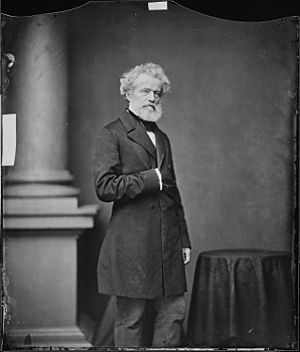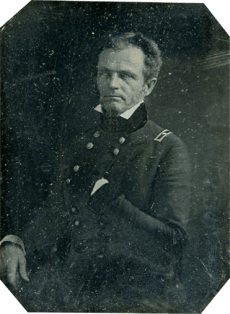John A. Quitman facts for kids
Quick facts for kids
John Quitman
|
|
|---|---|
 |
|
| Member of the U.S. House of Representatives from Mississippi's 5th district |
|
| In office March 4, 1855 – July 17, 1858 |
|
| Preceded by | Constituency established |
| Succeeded by | John McRae |
| 10th and 16th Governor of Mississippi | |
| In office January 10, 1850 – February 3, 1851 |
|
| Preceded by | Joseph W. Matthews |
| Succeeded by | John Guion |
| In office December 3, 1835 – January 7, 1836 Acting |
|
| Preceded by | Hiram Runnels |
| Succeeded by | Charles Lynch |
| Personal details | |
| Born | September 1, 1798 Rhinebeck, New York, U.S. |
| Died | July 17, 1858 (aged 59) Natchez, Mississippi, U.S. |
| Political party | Whig (before 1850) Democratic (1850–1858) |
| Spouse | Eliza Turner |
| Education | Hartwick College (BA) |
| Signature | |
| Military service | |
| Allegiance | United States |
| Branch/service | United States Army |
| Years of service | 1846–1848 |
| Rank | Major General |
| Unit | United States Volunteers |
| Commands | 2nd Brigade, 1st Volunteer Division 4th Volunteer Division Military Governor of Mexico City |
| Battles/wars | Texas Revolution Mexican–American War • Battle of Monterrey • Siege of Vera Cruz • Battle of Cerro Gordo • Battle of Contreras • Battle of Churubusco • Battle of Chapultepec • Battle for Mexico City |
John Anthony Quitman (born September 1, 1798 – died July 17, 1858) was an important American lawyer, politician, and soldier. He served as the Governor of Mississippi twice. He was also a Major General in the United States Army during the Mexican–American War.
Quitman was known for being very ambitious. He wanted to achieve military fame and political success. These goals were more important to him than managing his large farms and the many enslaved people who worked on them.
Contents
Early Life and Education
John Quitman was born in Rhinebeck, New York, in 1798. He studied classics at Hartwick Seminary and finished his studies in 1816.
After college, he worked as a teacher at Mount Airy College in Pennsylvania. However, he soon decided to study law instead.
In 1820, he became a lawyer and moved to Chillicothe, Ohio. The next year, he moved south to Natchez, Mississippi. In 1826, he bought a home called Monmouth. This home stayed in his family for 100 years.
Plantations and Enslaved People
John Quitman owned several large farms, called plantations. These included Springfield, Palmyra, Live Oaks, and Belen. These plantations grew crops like cotton, sugar, and molasses.
Quitman did not manage these farms himself. He hired white overseers to do this work. Many enslaved people worked on his plantations. For example, in 1848, 311 enslaved people worked at Palmyra.
Quitman was often away from his plantations. He and his family believed that owning enslaved people was acceptable. They thought that society in the Southern states was very stable because of this system.
Political Career
Quitman worked as a lawyer in Natchez until 1826. That year, he was elected to the Mississippi House of Representatives. In 1828, he became a Chancellor, which is a type of judge in the state.
He also helped write the state's new constitution in 1832. Quitman was a supporter of John C. Calhoun during the Nullification Crisis. This was a time when some states argued they could reject federal laws.
In 1835, he was elected to the State Senate. The next year, he became the President of the Senate. He also served as the acting Governor of Mississippi during this time.
In 1838, Quitman became a judge on the High Court of Errors and Appeal. He was also a leader in the Mississippi Masons, a social organization, for many years. He reached the highest level in Scottish Rite Masonry.
Service in the Mexican–American War
On July 1, 1846, during the Mexican–American War, Quitman became a Brigadier General of Volunteers. He led a group of soldiers under General Zachary Taylor in northern Mexico.
After the Battle of Monterrey, he joined General Winfield Scott's army. Quitman led a brigade during the Siege of Veracruz. On April 14, 1847, he was promoted to Major General in the regular army.
After the Battle of Cerro Gordo, Quitman was put in charge of the 4th Division. This division included soldiers from Veracruz and about 300 U.S. Marines. By this time, Quitman was known as a skilled military leader. Both volunteer and professional soldiers respected him.
Quitman's division moved to the Valley of Mexico. He was ordered to guard important supplies and a hospital. Even though he wanted to be on the front lines, he sent soldiers to help in battles. His brigade was involved in the battles of Contreras and Churubusco.
He led the attack from the south during the Battle of Chapultepec. U.S. Marines from Quitman's division led this attack. Their bravery in this battle is mentioned in the first line of the Marines' Hymn. Quitman accepted the surrender of the citadel in Mexico City.
After the fall of Mexico City, General Scott made Quitman the Military Governor of Mexico City. He was the only American to govern from inside the National Palace of Mexico. Quitman was also a founding member of the Aztec Club of 1847. He left the army on July 20, 1848.
Efforts to Liberate Cuba
As Governor of Mississippi, John Quitman was interested in helping to free Cuba from Spanish rule. He was asked by a Venezuelan named Narciso López to lead an expedition to Cuba in 1850. Quitman did not lead the expedition himself because he wanted to finish his term as governor. However, he did help López find men and supplies for the mission.
López's attempt to free Cuba failed. Later, with encouragement from President Franklin Pierce, Quitman began planning his own expedition to invade Cuba in 1853. Thousands of men were ready to go. However, in May 1854, the government changed its mind and stopped the plan. This was likely because adding a slaveholding territory like Cuba might have caused problems for the Democratic Party.
Return to National Politics
On March 4, 1855, Quitman was elected to the United States Congress. He served as a representative for the Democratic Party until his death. In Congress, he was the leader of the Committee on Military Affairs.
Death and Legacy
John A. Quitman died at his home, "Monmouth," near Natchez, Mississippi, on July 17, 1858. He was 58 years old. He likely died from an illness he caught during the inauguration of President James Buchanan. He was buried in the Natchez City Cemetery in Natchez, Mississippi.
Several places are named after John Quitman. These include the towns of Quitman, Texas, Quitman, Mississippi, Quitman, Georgia, and Quitman, Missouri. Two counties, Quitman County, Georgia and Quitman County, Mississippi, are also named in his honor. The military base Fort Quitman in west Texas and a Masonic Lodge in Georgia also carry his name.
See also
- List of United States Congress members who died in office (1790–1899)


